Projects need approval before they can be executed. A project charter is a project planning document that sells the project to stakeholders and sponsors. If you’re able to show its viability and return on investment, the work will get the green light to move forward.
But there are a lot of elements to any successful project charter. If you’re new to project management, a project charter template can set you up to make sure you’re hitting all the major points. We’ve included a free project template charter help as an example of what a project charter should include.
So, what is a project charter, exactly? The following quick guide will help give you a fuller understanding so that when you’re pitching your next project, you’ll have everything you need to achieve success.
What Is a Project Charter?
A project charter is the statement of scope, objectives and people who are participating in a project. It begins the process of defining the roles and responsibilities of those participants and outlines the objectives and goals of the project. The charter also identifies the main stakeholders and defines the authority of the project manager at the outset of the project plan.
In terms of a project charter’s meaning, this formal document is a high-level overview of the project. It keeps stakeholders aligned and offers a clear vision and direction for the project team to follow. For example, why is the project being undertaken, what are its goals and who are its stakeholders? Project charters also help secure the approval and resources for the project.
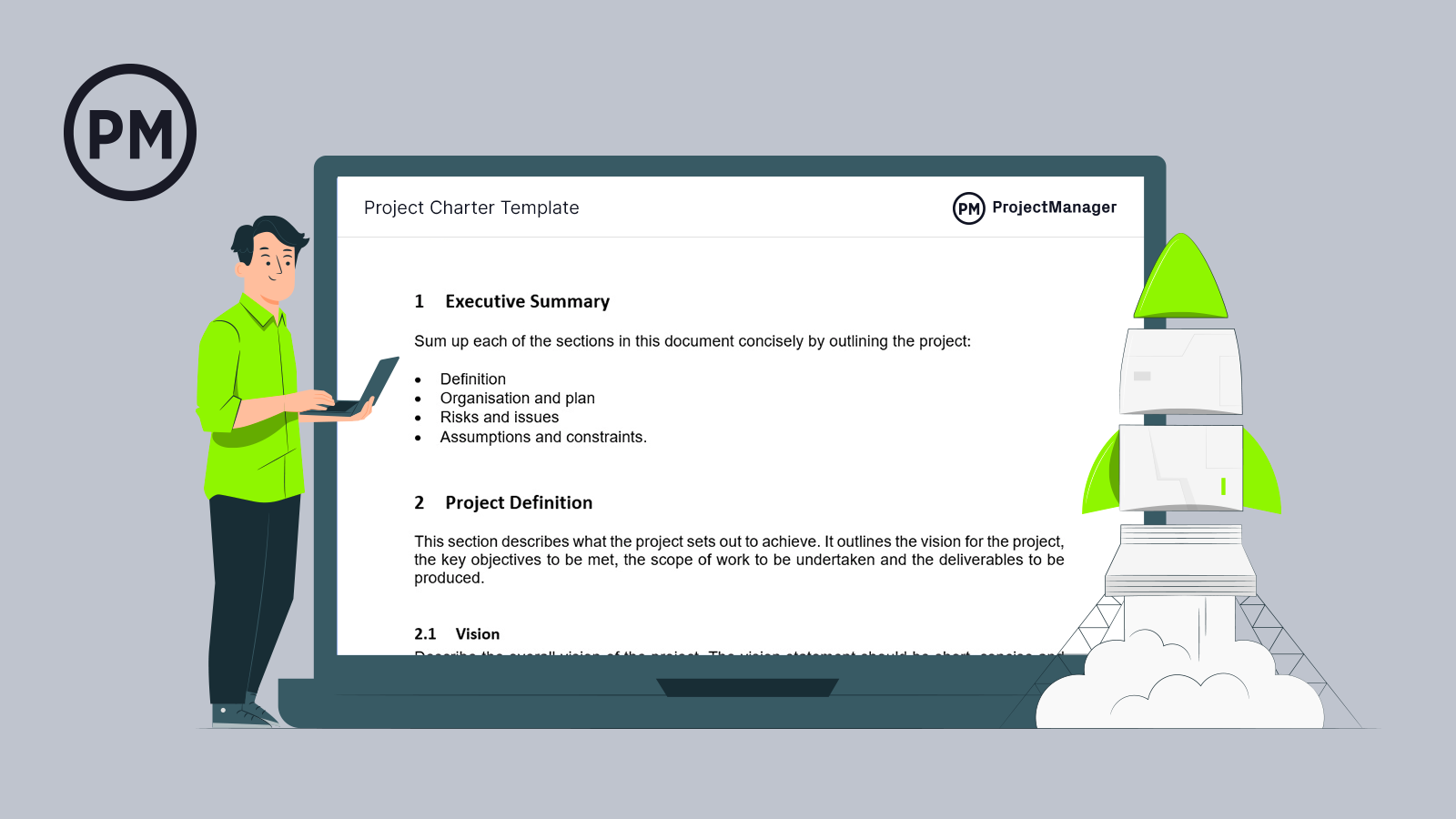
Get your free
Project Charter Template
Use this free Project Charter Template for Word to manage your projects better.
What Is the Purpose of a Project Charter?
There are a lot of documents necessary to run a project. Before you start, there are many you have to create, from a project plan to a project budget and more. All of these documents delve into detail on the items you’ve broadly covered in your project statement. So, why do you need another document, isn’t it redundant?
While it’s true you’re going to cover this ground on a granular level, this is your first pass; there’s a reason it’s more general and comes before everything else. The following are three main uses of the document:
- You need it to authorize your project. This is the document that sells the project to your stakeholders and defines broadly what their return on investment will be. It’s like an elevator pitch, so it has to sell the project.
- It serves as a primary sales document. When you present this to the stakeholders, they now have a summary to distribute or present when approached about other projects, so they can focus their resources where they’re needed.
- This is a document that stays with you throughout the life cycle of the project. You’ll be referring to it throughout, whether at meetings or to assist with scope management. The charter acts as a roadmap without the minutia to distract you from other project materials.
When to Write a Project Charter in Project Management
Now that we know what a project charter in project management is, let’s explore when to write one. Typically, the project charter is written at the beginning of a project, during the initiation phase and before stakeholder alignment is needed.
At this point, the project is formally defined and authorized, and the project charter can help provide information about the project’s purpose. The appointed project manager will usually step in once the project charter is finalized to ensure they can effectively manage the project.
Who Should Write a Project Charter?
A project manager typically writes the project charter, however, it requires collaboration with different stakeholders to be a success. While the project manager will lead the process and ensure clarity on objectives, scope and deliverables, the project sponsor, key stakeholders, subject matter experts and team members should also be involved and provide input. This collaborative approach helps build well-rounded project charters that align with all parties’ expectations.
Project Charter vs. Project Plan
To further understand what a project charter is, let’s compare it to other project documentation, which should bring it into sharper focus. We’ve already explained that a project charter is a high-level document used when initiating a project. It’s only a few pages long and outlines the objectives, scope, vision, team role and responsibilities as well as the stakeholders involved in the project.
The project plan is used to show how to execute the project. It’s a practical guide to running the project from start to finish. It comes after the project charter has been approved by the stakeholders and acts as a direction for the project plan. What’s outlined in the project charter is fleshed out and defined in far greater detail in the project plan. In that sense, they’re related and very much part of the larger progression of the project.
When we’re talking about a project plan, it’s a way to identify the value of the project for the stakeholders and organization. But then it gets down to a more practical level. There’s the creation of a project timeline, with tasks, duration and milestones. It structures the project team, their roles and responsibilities, and who will do what when executing the project. Resources are allocated, a work breakdown structure (WBS) is used to identify all the deliverables and costs are estimated.
Project Charter vs. Business Case
As already defined, a project charter is a high-level description of the project and its deliverables. But a business case, as the name suggests, speaks to the value of the project, what the return on investment (ROI) will be or how it positions the organization to exploit opportunities in the future.
Therefore, a business case focuses on the business opportunities or a problem to be fixed by the project. These benefits can be tangible or intangible, such as increasing profits or market saturation. Whatever they are, the benefits are supported by a detailed analysis of the ROI. Any assumptions and constraints are listed.
So while a project charter is a broader document, the business case is only interested in what the project can do to help the organization. It justifies the project and the time, money and effort it’ll take to complete the project. A project charter authorizes the project and the business case is the research to prove the viability of the time, money and effort required to execute the project.
Project Charter Template
Writing a project charter takes time and effort and it can be challenging if you’re new to project planning. But you don’t have to worry, you can use our free project charter template to get started. Use it as a project charter example to work from, then keep reading our blog to learn how to make a project charter for your project.
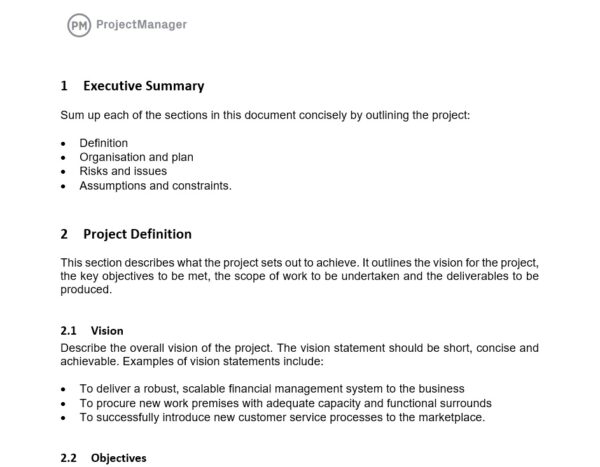
How to Write a Project Charter: Key Elements of a Project Charter
The project management charter serves as a reference document. It should answer these key questions during the initiation phase.
- What is the essence of the project? What are the goals and objectives of the project? How are you planning to reach and achieve these goals and objectives?
- Why does this project exist? Provide a shared understanding of the project. The charter should communicate its value and/or reason for existence to every person who has a part in it, from the team to the project manager, stakeholders, sponsors, etc.
- Can we agree on this project? The charter acts as a contract between the project sponsor, key stakeholders and the project team. By noting the responsibilities of each party involved, everyone is clear about what their duties are.
So, those are the broad strokes, and while a project statement doesn’t need to go into great detail, there are many more key elements to it than these general statements. Remember, the sections outlined below should be short because they refer to more detailed project planning documents, such as a scope statement, project budget, risk management plan or request for proposal.
1. State the Project Information
This first section in your project charter is where you’ll include your project’s general information, such as its name, description and who are the project sponsor, project manager, team members and stakeholders.
2. Identify the Project Sponsor and Authorizing Party
Usually, the project sponsor or authorizing party will be a senior manager or executive with the authority to approve the project and oversee resource allocation. They will help provide direction, get the necessary funding, act as a liaison between stakeholders and resolve any conflicts that come up. The project sponsor plays an important role as they help ensure the project is meeting organizational objectives and cross-departmental collaboration.
3. Establish the Project Purpose
Next, the purpose of the project management charter needs to be established. In other words, clearly articulate why the project is happening and what it plans to accomplish. Parts to include in the project purpose are the problem or opportunity, goals, organizational objectives and benefits. Always use simple, digestible language so all stakeholders are clear on the project’s intent.
4. Identify Project Goals and Project Objectives
It’s important for project managers to differentiate between these two. Project goals are the high-level benefits that the project should generate, while project objectives are the specific milestones or steps that are needed to complete them. If you don’t have a clear target, your project is going to miss the mark.
5. Define Project Team Roles & Responsibilities
An important function of a project charter is to document your team members and their roles and responsibilities. You should also identify the main stakeholders. It’s always crucial to note the stakeholders in any project as they’re the ones who you’ll be reporting to and, in a sense, managing their expectations. The sooner you know who they are, the sooner you can build a productive stakeholder management plan.
- Project Manager: Leades the process of drafting the charter and ensuring clarity.
- Project Sponsor: Offers initial direction and approvals on the project’s alignment with overall organizational goals.
- Project Management Office (PMO): Ensures that project charters are structured appropriately and align with organizational objectives.
- Project Stakeholders: Provide various input to guarantee that all requirements and perspectives are factored in.
6. Present a Business Case
A project charter needs a business case because it essentially states the reasons for undertaking the project. It helps project managers explain the business needs that the project will meet and the expected financial benefits and return on investment for project stakeholders. A good way to sell the project is to have a sense of what good the project will bring to sponsors and stakeholders. Figure out what those benefits are and list them here.
7. Outline the Project Scope
What are the in-scope and out-of-scope items? The scope is the boundaries of your project, such as its start date and when it concludes. So, what are the in-scope items, such as those parts of the project process as opposed to tasks or actions that lay outside the step-by-step process of the project? Outline your key project deliverables and milestones. Later, during the planning phase, you’ll need to create a scope statement that describes the project scope in more depth.
8. Create a Project Timeline
A project timeline is a simplified version of your project schedule. This project timeline should show key deliverables, milestones and project stages so that stakeholders understand the big picture.
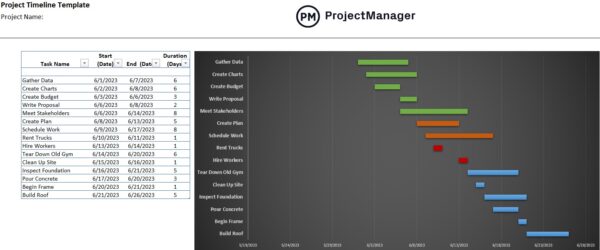
9. Estimate What Resources Will Be Needed
The project charter document should include the needed personnel, budget, materials and tools to complete the project. Once the resource types are identified, break them down by phases so the team understands when resources will be used. A clear estimation of resources in the project charter helps build a stable foundation for the planning and execution phases.
10. Build the Project Budget
While you’ll go into greater detail when you create the project budget, here’s where you want to get a ballpark figure on what project costs you expect, based on the resources required to execute project tasks. Define the budget for the project and who will have spending authority. Include the estimated costs for the tasks you’ve defined, but be aware that new project requirements and tasks will require adjustment of this budget.

11. Conduct a Cost-Benefit Analysis
A cost-benefit analysis helps stakeholders better understand the project’s financial implications and return on investment (ROI). As a result, the stakeholders can make more informed decisions. Various components of a cost-benefit analysis are needed such as direct and indirect costs, project benefits that are both tangible and intangible as well as the overall return on investment. A template can help with this somewhat complicated step.
12. Note Key Assumptions & Constraints
It’s important to write down all the assumptions or constraints that can have an impact on the development or execution of your project plan. Noting key assumptions is very important for stakeholder management, as setting clear expectations is key to success. You also want to have at least an outline of how you’re going to deal with project constraints. If you don’t cover it now, you’ll have to play catch-up later.
13. Log Key Project Risks
Identify all potential risks that could arise in the project so you’re not taken by surprise. Here, you’ll want to highlight the most probable or impactful risks so that stakeholders are aware of them early. This should be followed by a risk register and risk management plan in your project plan, where you detail how you’ll resolve those risks and who on the team is responsible for catching and fixing them.
14. Define Project Requirements and Success Criteria
The project management team and project stakeholders must reach an agreement in terms of success criteria. The most common aspects to determine project success are the triple constraint elements, time, cost and scope. But depending on the project, there can be many project requirements such as risk tolerance levels and quality standards.
Project Charter Examples
Now, let’s use the steps above to write two simple project charter examples.
Construction Project Charter Example
For this project charter example, let’s imagine a construction firm that’s going through the initiation phase of a residential construction project, more specifically an apartment complex.
Project Information
- Company: Acme Construction Co
- Project Name: Luxury Apartments at York
- Project Description: The project consists of the construction of a luxury apartment complex, featuring three types of floor plans going from 800 to 1,350 square feet
Roles & Responsibilities
- Lead Architect: Helena Johnson
- Lead Engineer: Samuel Weiss
- Construction Project Manager: Frederick Terry
- Cost Estimator: Danielle DuPont
- Project Administrator: Luke Robinson
- Site Supervisor: David Rosenthal
Project Vision and Objectives
- Project Vision: Completion on time, within budget, to exploit housing needs in the area.
- Project Objectives: 1. Hire construction crew members as needed, 2. Procure any materials or equipment as needed, 3. Transport materials and equipment to the construction site as instructed by the construction project manager and site supervisor, 4. Fill out daily construction reports to monitor the performance of the construction team.
Business Case
The district is ripe for housing. Recent mixed-use construction has produced popular retail and restaurants. The area is lacking in luxury residential housing for the moneyed class which has increasingly made this part of the city a destination. Attached is supporting research, demographics, etc.
Project Scope
The construction project will be built as per the construction drawings, specifications and other documents such as the construction plan and construction schedule.
Project Timeline
The project is expected to start by the last quarter of the year and be completed between 12-16 months.
Project Budget
The project budget is $15 million, based on the number of units and their square footage, as specified in the construction drawings, architectural designs and computer-assisted designs (CAD) models. The project budgeting process was completed thanks to a cross-functional effort by the architecture, engineering and cost estimation team.
Project Assumptions
- It’s assumed that no act of God such as earthquakes, tornados or hurricanes will cause the project to stop.
- It’s assumed that the equipment will be in optimal conditions so that the construction phase will be completed normally.
- It’s assumed that there are enough construction crew employees to complete the project.
- It’s assumed that construction subcontractors will complete their work plan on time.
Project Constraints
- The project shall not take longer than 18 months. If the construction team is running behind schedule, additional subcontractors might be hired without exceeding the project budget.
- The project has a budget of $15 million that must be monitored by the construction project manager. This project budget already contemplates a contingency fund in case there are over-costs, so it should not be exceeded for any reason.
Project Risks
The following risks might affect this project:
- Unexpected increases in material costs
- Unavailability of project resources such as labor, materials and equipment due to external factors
- Damage or theft of company equipment
- Natural disasters
Project Requirements and Success Criteria
The quality, safety standards, success criteria and other requirements for this project are explained in the construction drawings and construction specification documents. These include but are not limited to the quality of materials, skills required from the construction crew, environmental compliance standards and building codes.
Website Project Charter Example
For another project charter example, we’ll look at something less physical, the creation of a website. While the deliverables for the project charter example are tangible, they’ll still follow a similar outline as with the construction project charter or, frankly, any project.
Project Information
- Company: Widgets Manufacturing
- Project Name: Widgets.com
- Project Description: Creation of a dynamic website to brand the company, attract customers and sell products online.
Roles & Responsibilities
- Project Manager: Tony Richardson
- Lead Designer: Stacy Keach
- Content Director: William Macy
- Backend Developer: Ron Stable
- Frontend Developer: Lucy Kennedy
- UX Designer: Kate Fallon
- Quality Tester: Joan Anderson
Project Vision and Objectives
- Project Vision: On-time delivery of a robust website that captures leads with strong SEO and sells products simply.
- Project Objectives: 1. Hire a design and content team to build modern-looking graphics with lively writing, 2. Create sitemap, 3. Purchase software and hardware to build and maintain the site, 4. Generate and present regular reports for tracking progress and updating stakeholders
Business Case
Currently, Widgets Manufacturing has the capacity to deliver its popular brand at retail locations around the country. To broaden its global brand in a cost-effective manner, the development of a website to further its reach is the next step to grow and increase profitability.
Project Scope
The website is constructed to match the sensibilities of Widget’s target audience. Deliverables include design rough and finish, graphic elements, content, backend and frontend development and testing.
Project Timeline
The project is to be finished by the end of the year to exploit the seasonal spike in buying. Estimates for the timeline are six months.
Project Budget
The project is estimated to cost $1 million. A breakdown of equipment and labor is attached.
Project Assumptions
- End-users will test the website during a soft launch
- The website will work as designed
- There will be no cost overruns
- The project scope will remain unchanged once stakeholders have signed off
Constraints
- The website must be live prior to the end of the year to take advantage of seasonal buying.
- The budget is firm and has a cushion built in for unexpected costs.
Project Risks
The following risks might affect this project:
- Too many decision-makers delay the completion of the project
- Staff turnover
- Scope creep
- Fine-tuning graphics and content
Project Requirements and Success Criteria
The website must be completed on time and within budget. It should be consistent with the overall brand image of Widget Manufacturing and speak to our customers’ needs. The collection of leads and the delivery of goods, including secure payment, should all work as designed.
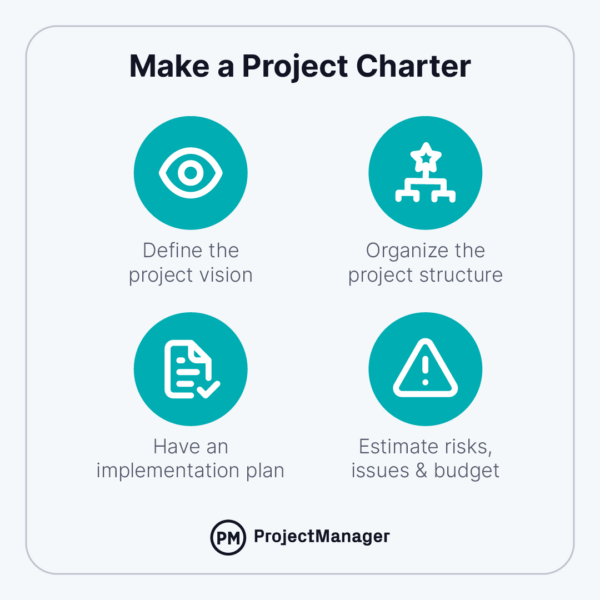
Tips on Writing a Project Management Charter
There’s a process for writing a project charter, which starts with knowing what the vision of the project is. That vision statement can’t be vague, but must capture the purpose of your project, defining the end goal for the project team.
Vision
Once you have the vision clear, then you can break it down into more practical bits.
- Objective. List three to five objectives of the project that are SMART: specific, measurable, achievable, realistic and time-bound.
- Scope. Now outline the formal boundaries of the project by describing how the business may change or alter by the delivery of your project, also note what’s relevant to the scope of work and what is not. This is how you maintain better control of the project.
- Deliverables. Describe each of the deliverables the project is tasked to produce. Once you’ve gotten all of them down, you’ve got a foothold on your charter and are ready to move on. You can use a WBS template to help identify your deliverables.
Organize
When you’re building a structure for your charter, there are four subsets you need to identify. This is done by listing the following:
- Customers/End Users. To complete this list, ask yourself: What is a customer and/or end-user in the context of this project? Who are the project customers? Is there a specific individual or entity responsible for accepting the deliverables of the project?
- Stakeholders. As noted earlier, identifying the stakeholders of the project is crucial. They’re the person or entities within or outside of the project with a key interest in that project. It might be a financial controller overseeing costs or the CEO, but whoever it is, they’ll have a slightly different focus depending on their role.
- Roles. You need to assign the key roles and responsibilities to those involved in delivering the project, from the project sponsor, project board and project manager. After each entry, write a short summary defining their role and what their responsibilities are in the project.
- Structure. Now you need to define the lines of reporting between these various roles in the project. Use a project organization chart to do this. It diagrams the structure of an organization and the relationships and roles of those involved in the project.
Implementation
You have a vision and have organized the various parts of your project. Now you have to develop a plan to implement them. There are four parts to this:
- Plan. If you’re going to implement, then you need an implementation plan. This is a way to develop an atmosphere of confidence for your customers and stakeholders by listing the phases, activities and timeframes of the project’s life cycle.
- Milestones. Milestones mark major phases in the project and collect smaller tasks into bigger chunks of work. The project should only have a few of them, that’s why they’re milestones, but they’re an important way to acknowledge the completion of a key deliverable.
- Dependencies. List all key dependencies and their importance to the project. These are tasks or activities that are linked to one another, as they’ll impact the project during its life cycle.
- Resource Plan. What resources are involved in the project? Break down this list into labor, equipment and materials. This is how you’ll know what you need before you need it, and you’ll be able to estimate your budget more accurately. As the project progresses and changes are introduced, you’ll need to adapt your resource plan. ProjectManager features workload and resource management tools that let you quickly see everyone’s workload, so you can reassign tasks as necessary. This keeps everyone from being over or underworked.
Take the Next Step in Planning with ProjectManager
The charter lays the groundwork for the project. It provides a vision and determines where all the parts will be placed. It’s a great framework, but it’s not a plan. The charter leads to project planning, and ProjectManager is award-winning project management software you need to manage your project from start to finish.
Gantt Charts for Planning
Turning a charter into a plan requires a tool that’s flexible enough to respond and adjust to the many tasks involved. The online Gantt chart project view takes tasks and populates a project timeline, where dependencies can be linked-to avoid bottlenecks later. Set milestones, quickly edit dates and even assign work to team members.
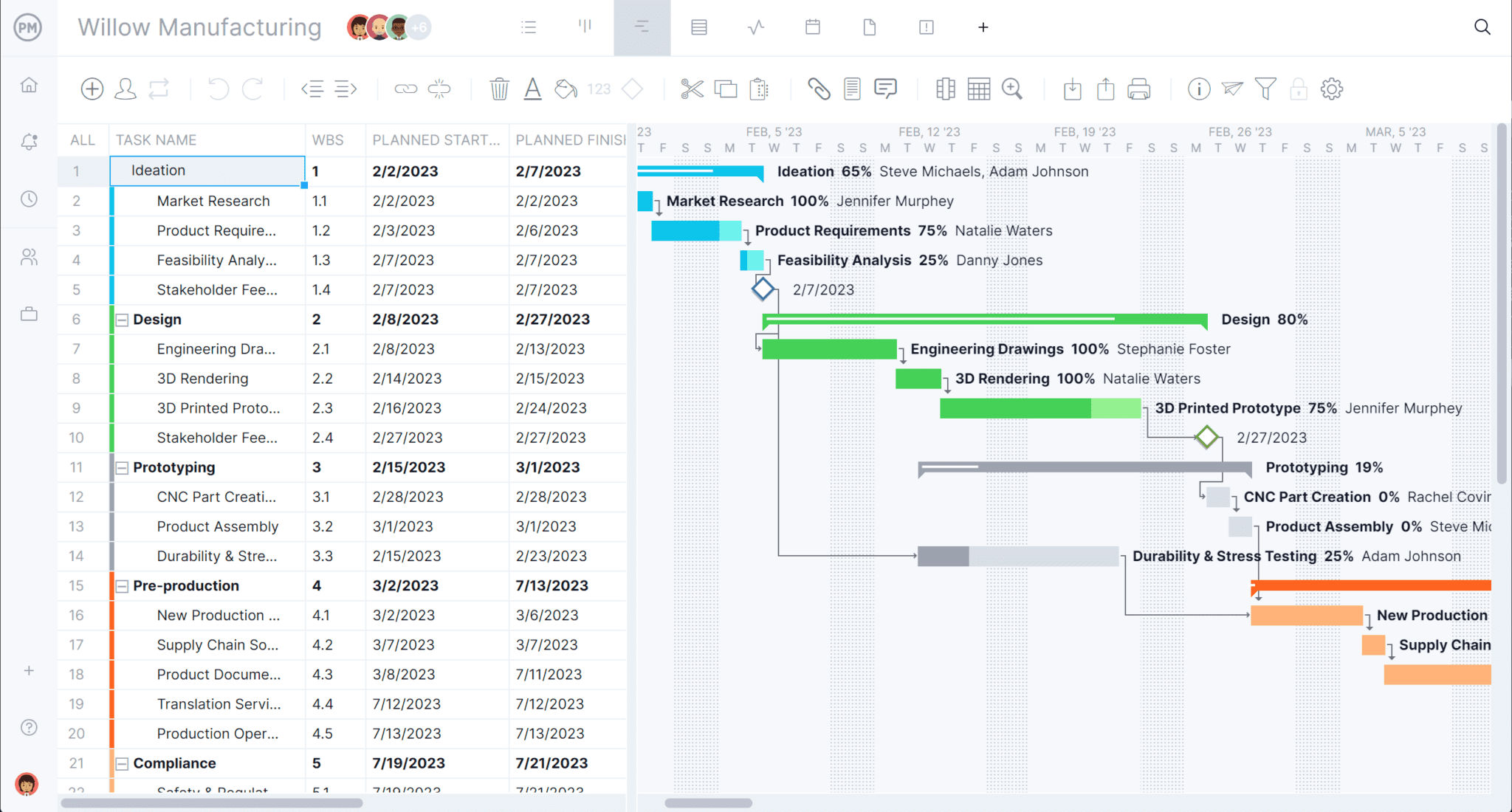
Collaborate on Tasks
When assigning teams, it’s critical that they have clear directions. Project managers have too much to do to spend time micromanaging their teams. ProjectManager makes assigning easy, but also with its unlimited file storage, you can attach as many documents and images as necessary for instruction. Comments can be made at the task level, so there’s always a channel open between team members to communicate and collaborate.

Once you’ve written your project charter and have approval from your stakeholders, you’re going to need the right tools to manage the scope, tasks and resources of your project to ensure you deliver it under budget and on schedule. ProjectManager is online project management software that reports instantly when statuses are updated, so you know where your project is and how to keep it moving toward successful completion. Try our award-winning software now with this free 30-day trial.


